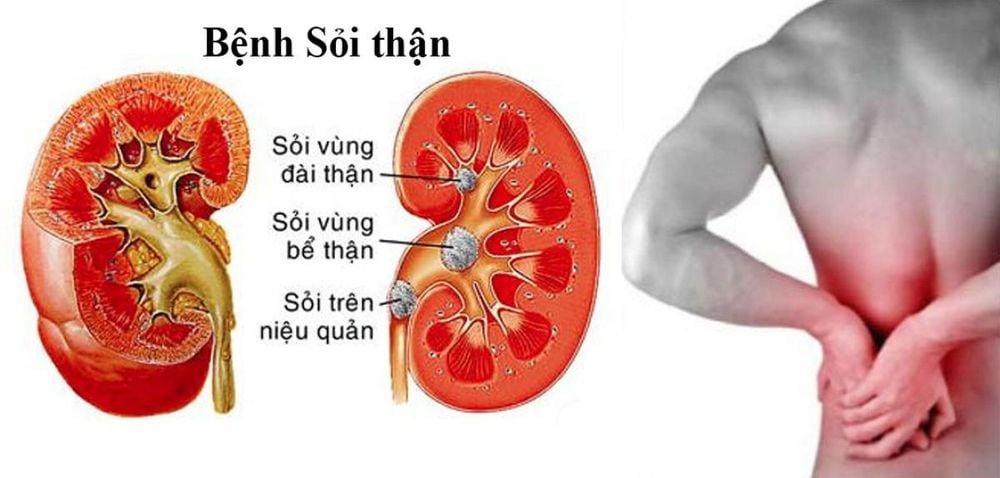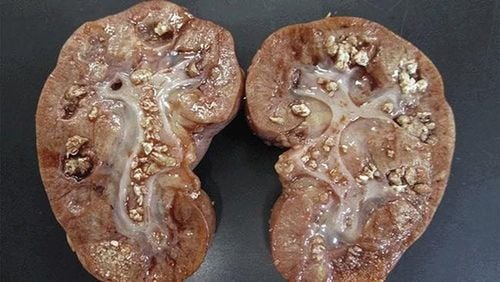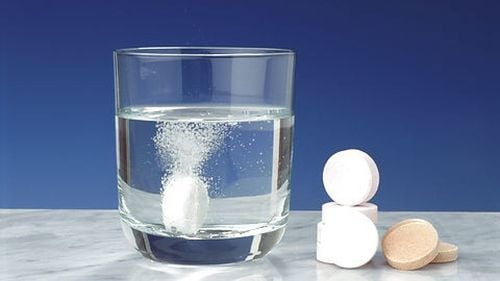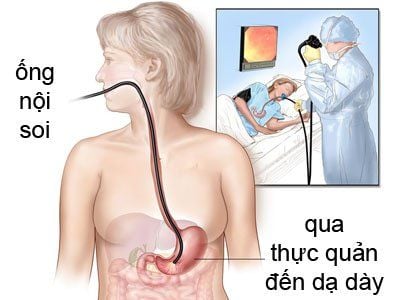This is an automatically translated article.
The article was professionally consulted by Doctor Department of General Surgery and Anesthesia, Vinmec Hai Phong International General Hospital.
Kidney stones (or kidney stones) are stones that form in the urinary tract. This is the result of the crystallization of minerals in the urine and deposited in the kidney, where it accumulates for a long time to form stones. Kidney stones may have no symptoms and pass on their own. However, large stones can cause blockages, causing terrible kidney pain.
1. Formation of kidney stones
Most kidney stones are invisible to the naked eye. However, by combining these tiny particles together, over time, kidney stones will grow larger and cause painful symptoms, typically severe renal colic. There are five main chemical constituents of kidney stones: calcium oxalate, calcium phosphate, struvite, uric acid, and cysteine. Among them, kidney stones with a chemical composition of calcium oxalate are the most common.
The formation of kidney stones is based on a high concentration of crystals. For example, calcium oxalate crystals are filtered through the kidneys and into the urine. There, they quickly bond together and form crystals. There are two basic types of crystals:
Homogeneous is a crystal consisting of molecules surrounding a nucleus of the same structure. A heterogeneous type is a crystal consisting of molecules surrounding a nucleus with a different structure, such as cell debris. Kidney stones are formed when the amount of urine is too little or the concentration of the above minerals in the urine is high, deposited in the kidney, over time, forming stones. These crystals are produced through the filtration of blood in the renal tubules that form urine. They are usually deposited at the renal papilla because this is where the crystals will undergo the bonding phase. Over time, the crystal will grow larger and larger, forming a stone and being retained by the kidney and continuing to grow.
2. Evolution of kidney stones
Kidney stones are usually excreted in the urine, but in the beginning, most patients do not feel the presence of kidney stones because the stones are too small. But as the stones grow to be 4 to 5 mm in size, they do not pass through the anatomical narrowing of the ureter. Therefore, the sharp edges on the stone surface can obstruct them in the lumen of the ureter at any location. Especially at the narrow segment of the ureter, when it crosses with the iliac artery before leading into the bladder, the stuck stone will cause severe pain until the stone falls into the bladder and is eliminated when urinating. .
78% of stones will pass spontaneously without any specific intervention. However, when the stone becomes lodged in the ureter, the urologist will need to perform lithotripsy or surgery to remove the stone.
One of the highly effective, less invasive and widely used lithotripsy methods is endoscopic laser lithotripsy with a flexible bronchoscope. This method has the outstanding advantage of helping to preserve the maximum kidney function, helping the patient to have less pain, quick recovery and no scarring due to completely natural surgery. This is an advanced and technically demanding kidney stone treatment method, which can only be performed in large hospitals. Currently, Vinmec International General Hospital has put into practice this method.
Please dial HOTLINE for more information or register for an appointment HERE. Download MyVinmec app to make appointments faster and to manage your bookings easily.

3. Causes of kidney stones
Many theories have been put forward to explain crystal deposition - the cause of kidney stones.
Not drinking enough water makes the urine too concentrated, the concentration of crystals becomes saturated in the urine. Congenital or acquired malformations of the urinary tract make it impossible for urine to escape, but accumulate, eventually forming kidney stones. Patients with prostate enlargement, fibroids, diverticula in the bladder cause urine to collect in the interstitium. After a severe injury, he could not walk, but lay in one place. Having recurrent genital infections, giving bacteria the opportunity to invade, causing persistent urinary tract inflammation, over time, it will create pus and deposit secretions, forming kidney stones. . Diet high in oxalate, calcium, long-term use of certain drugs such as acetazolamide, loop diuretics, thiazides, glucocorticoids, theophylline, vitamin D, vitamin C.. Kidney stones are common but sometimes silent disease. inside the body without causing any trouble. However, early detection and proactive elimination of kidney stones by natural means is always a good thing to do before they cause serious complications.













